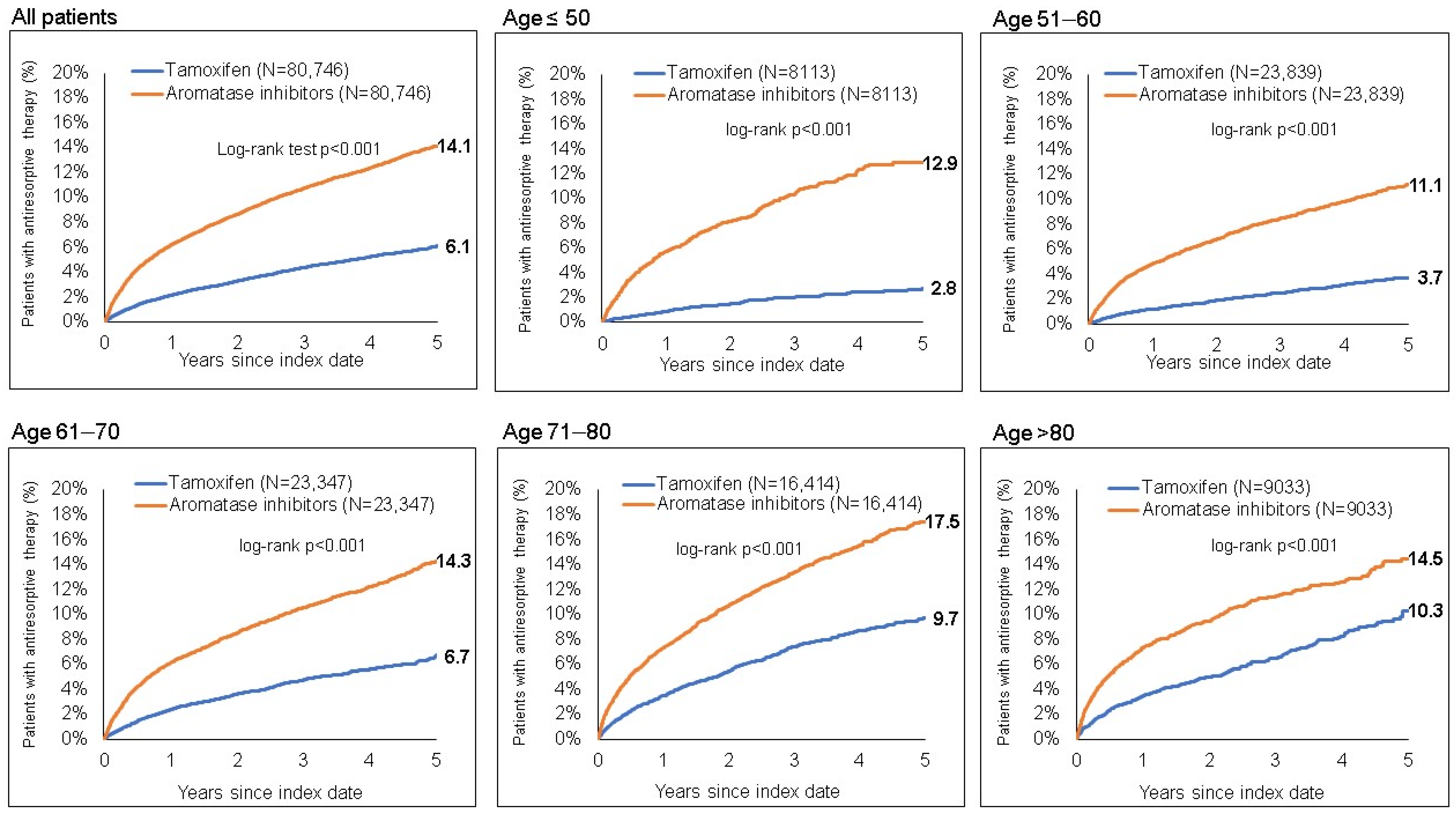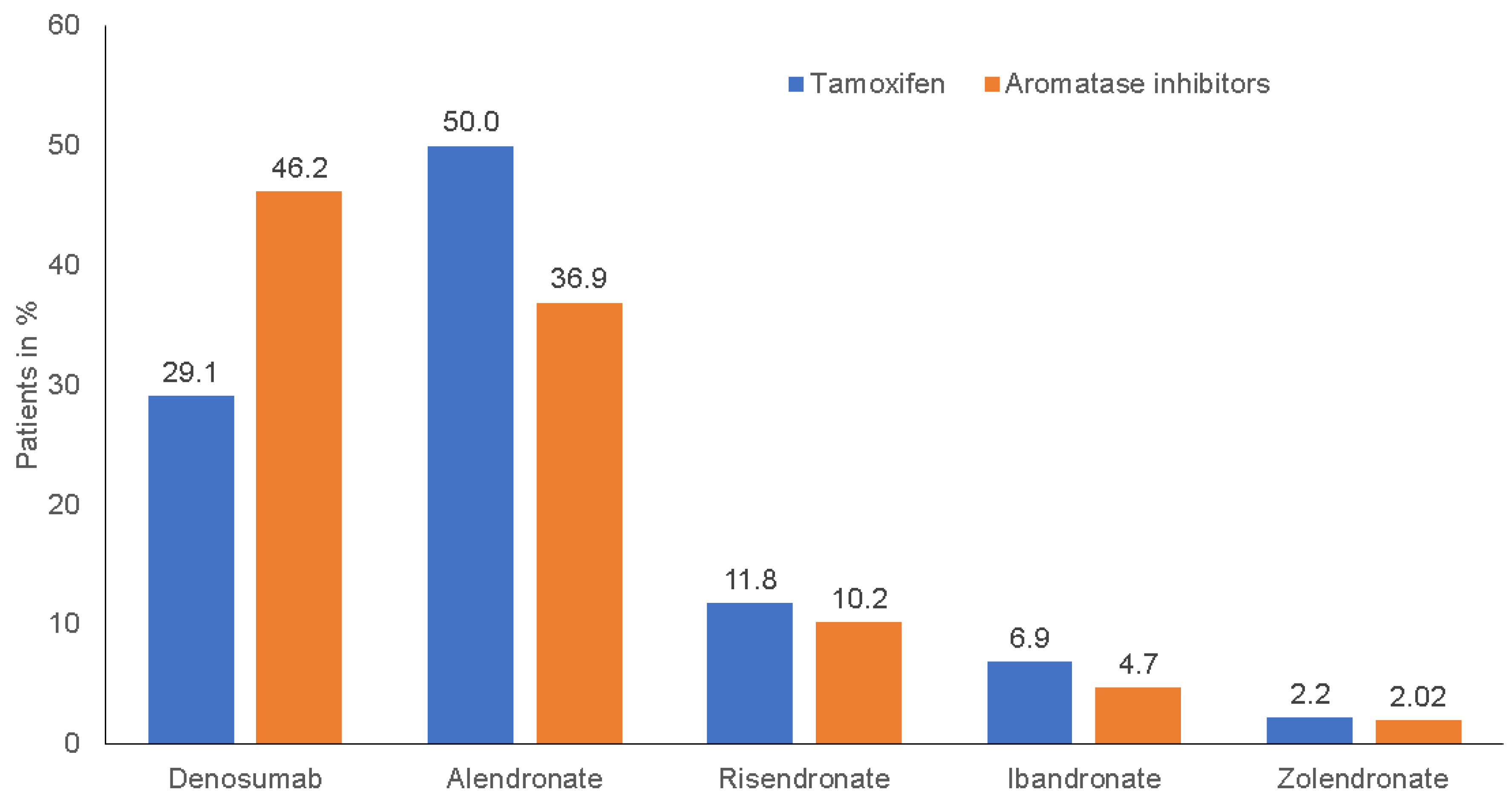Initiation of Antiresorptive Drug Treatment during Endocrine Therapy for Breast Cancer—A Retrospective Cohort Study of 161,492 Patients in Germany
Abstract
Simple Summary
Abstract
1. Introduction
2. Materials and Methods
2.1. Database
2.2. Study Population and Outcomes
2.3. Statistical Analyses
3. Results
3.1. Basic Characteristics of the Study Sample
3.2. Incidence of Antiresorptive Therapy
3.3. Antiresorptive Drugs Prescribed
4. Discussion
5. Conclusions
Author Contributions
Funding
Institutional Review Board Statement
Informed Consent Statement
Data Availability Statement
Conflicts of Interest
References
- Smolarz, B.; Nowak, A.Z.; Romanowicz, H. Breast Cancer-Epidemiology, Classification, Pathogenesis and Treatment (Review of Literature). Cancers 2022, 14, 2569. [Google Scholar] [CrossRef]
- Harbeck, N.; Penault-Llorca, F.; Cortes, J.; Gnant, M.; Houssami, N.; Poortmans, P.; Ruddy, K.; Tsang, J.; Cardoso, F. Breast cancer. Nat. Rev. Dis. Primers 2019, 5, 66. [Google Scholar] [CrossRef]
- Early Breast Cancer Trialists’ Collaborative, G.; Davies, C.; Godwin, J.; Gray, R.; Clarke, M.; Cutter, D.; Darby, S.; McGale, P.; Pan, H.C.; Taylor, C.; et al. Relevance of breast cancer hormone receptors and other factors to the efficacy of adjuvant tamoxifen: Patient-level meta-analysis of randomised trials. Lancet 2011, 378, 771–784. [Google Scholar] [CrossRef] [PubMed]
- Waks, A.G.; Winer, E.P. Breast Cancer Treatment: A Review. JAMA 2019, 321, 288–300. [Google Scholar] [CrossRef]
- Tong, C.W.S.; Wu, M.; Cho, W.C.S.; To, K.K.W. Recent Advances in the Treatment of Breast Cancer. Front. Oncol. 2018, 8, 227. [Google Scholar] [CrossRef] [PubMed]
- Font, R.; Buxo, M.; Ameijide, A.; Martinez, J.M.; Marcos-Gragera, R.; Carulla, M.; Puigdemont, M.; Vilardell, M.; Civit, S.; Vinas, G.; et al. Using population-based data to evaluate the impact of adherence to endocrine therapy on survival in breast cancer through the web-application BreCanSurvPred. Sci. Rep. 2022, 12, 8097. [Google Scholar] [CrossRef] [PubMed]
- Hodges, L.C.; Cook, J.D.; Lobenhofer, E.K.; Li, L.; Bennett, L.; Bushel, P.R.; Aldaz, C.M.; Afshari, C.A.; Walker, C.L. Tamoxifen functions as a molecular agonist inducing cell cycle-associated genes in breast cancer cells. Mol. Cancer Res. 2003, 1, 300–311. [Google Scholar] [PubMed]
- Early Breast Cancer Trialists’ Collaborative, G. Aromatase inhibitors versus tamoxifen in early breast cancer: Patient-level meta-analysis of the randomised trials. Lancet 2015, 386, 1341–1352. [Google Scholar] [CrossRef]
- Group, B.I.G.C.; Mouridsen, H.; Giobbie-Hurder, A.; Goldhirsch, A.; Thurlimann, B.; Paridaens, R.; Smith, I.; Mauriac, L.; Forbes, J.; Price, K.N.; et al. Letrozole therapy alone or in sequence with tamoxifen in women with breast cancer. N. Engl. J. Med. 2009, 361, 766–776. [Google Scholar] [CrossRef]
- Chumsri, S.; Howes, T.; Bao, T.; Sabnis, G.; Brodie, A. Aromatase, aromatase inhibitors, and breast cancer. J. Steroid Biochem. Mol. Biol. 2011, 125, 13–22. [Google Scholar] [CrossRef]
- Johnston, S.R.; Dowsett, M. Aromatase inhibitors for breast cancer: Lessons from the laboratory. Nat. Rev. Cancer 2003, 3, 821–831. [Google Scholar] [CrossRef] [PubMed]
- Schneeweiss, A.; Fasching, P.A.; Fehm, T.; Gerber, B.; Jackisch, C.; Loibl, S.; Schmidt, M.; Stickeler, E.; Wockel, A.; Janni, W.; et al. AGO Algorithms for the Treatment of Breast Cancer: Update 2021. Geburtshilfe Frauenheilkd. 2021, 81, 1101–1111. [Google Scholar] [CrossRef] [PubMed]
- Hadji, P.; Aapro, M.S.; Body, J.J.; Gnant, M.; Brandi, M.L.; Reginster, J.Y.; Zillikens, M.C.; Gluer, C.C.; de Villiers, T.; Baber, R.; et al. Management of Aromatase Inhibitor-Associated Bone Loss (AIBL) in postmenopausal women with hormone sensitive breast cancer: Joint position statement of the IOF, CABS, ECTS, IEG, ESCEO IMS, and SIOG. J. Bone Oncol. 2017, 7, 1–12. [Google Scholar] [CrossRef] [PubMed]
- Hadji, P. Aromatase inhibitor-associated bone loss in breast cancer patients is distinct from postmenopausal osteoporosis. Crit. Rev. Oncol./Hematol. 2009, 69, 73–82. [Google Scholar] [CrossRef] [PubMed]
- Shapiro, C.L. Osteoporosis: A Long-Term and Late-Effect of Breast Cancer Treatments. Cancers 2020, 12, 3094. [Google Scholar] [CrossRef]
- Rabaglio, M.; Sun, Z.; Price, K.N.; Castiglione-Gertsch, M.; Hawle, H.; Thurlimann, B.; Mouridsen, H.; Campone, M.; Forbes, J.F.; Paridaens, R.J.; et al. Bone fractures among postmenopausal patients with endocrine-responsive early breast cancer treated with 5 years of letrozole or tamoxifen in the BIG 1–98 trial. Ann. Oncol. 2009, 20, 1489–1498. [Google Scholar] [CrossRef]
- Amir, E.; Seruga, B.; Niraula, S.; Carlsson, L.; Ocana, A. Toxicity of adjuvant endocrine therapy in postmenopausal breast cancer patients: A systematic review and meta-analysis. J. Natl. Cancer Inst. 2011, 103, 1299–1309. [Google Scholar] [CrossRef]
- Colzani, E.; Clements, M.; Johansson, A.L.V.; Liljegren, A.; He, W.; Brand, J.; Adolfsson, J.; Fornander, T.; Hall, P.; Czene, K. Risk of hospitalisation and death due to bone fractures after breast cancer: A registry-based cohort study. Br. J. Cancer 2016, 115, 1400–1407. [Google Scholar] [CrossRef]
- Edwards, B.J.; Gradishar, W.J.; Smith, M.E.; Pacheco, J.A.; Holbrook, J.; McKoy, J.M.; Nardone, B.; Tica, S.; Godinez-Puig, V.; Rademaker, A.W.; et al. Elevated incidence of fractures in women with invasive breast cancer. Osteoporos. Int. 2016, 27, 499–507. [Google Scholar] [CrossRef]
- Edwards, B.J.; Raisch, D.W.; Shankaran, V.; McKoy, J.M.; Gradishar, W.; Bunta, A.D.; Samaras, A.T.; Boyle, S.N.; Bennett, C.L.; West, D.P.; et al. Cancer therapy associated bone loss: Implications for hip fractures in mid-life women with breast cancer. Clin. Cancer Res. 2011, 17, 560–568. [Google Scholar] [CrossRef]
- Rachner, T.D.; Coleman, R.; Hadji, P.; Hofbauer, L.C. Bone health during endocrine therapy for cancer. Lancet Diabetes Endocrinol. 2018, 6, 901–910. [Google Scholar] [CrossRef]
- Goldvaser, H.; Amir, E. Role of Bisphosphonates in Breast Cancer Therapy. Curr. Treat. Options Oncol. 2019, 20, 26. [Google Scholar] [CrossRef]
- Chen, J.S.; Sambrook, P.N. Antiresorptive therapies for osteoporosis: A clinical overview. Nat. Rev. Endocrinol. 2011, 8, 81–91. [Google Scholar] [CrossRef] [PubMed]
- Russell, R.G.G.; Watts, N.B.; Ebetino, F.H.; Rogers, M.J. Mechanisms of action of bisphosphonates: Similarities and differences and their potential influence on clinical efficacy. Osteoporos. Int. 2008, 19, 733–759. [Google Scholar] [CrossRef] [PubMed]
- Miller, P.D.; Bolognese, M.A.; Lewiecki, E.M.; McClung, M.R.; Ding, B.; Austin, M.; Liu, Y.; San Martin, J. Effect of denosumab on bone density and turnover in postmenopausal women with low bone mass after long-term continued, discontinued, and restarting of therapy: A randomized blinded phase 2 clinical trial1*Edited by: Stuart Ralston. Bone 2008, 43, 222–229. [Google Scholar] [CrossRef] [PubMed]
- Richter, H.; Dombrowski, S.; Hamer, H.; Hadji, P.; Kostev, K. Use of a German longitudinal prescription database (LRx) in pharmacoepidemiology. Ger. Med. Sci. 2015, 13, Doc14. [Google Scholar] [CrossRef] [PubMed]
- Gremke, N.; Griewing, S.; Chaudhari, S.; Upadhyaya, S.; Nikolov, I.; Kostev, K.; Kalder, M. Persistence with tamoxifen and aromatase inhibitors in Germany: A retrospective cohort study with 284,383 patients. J. Cancer Res. Clin. Oncol. 2022. [Google Scholar] [CrossRef] [PubMed]
- Kap, E.; Konrad, M.; Kostev, K. Persistence with selective serotonin (norepinephrine) reuptake inhibitors in Germany-A retrospective database analysis. J. Affect. Disord. 2019, 247, 156–160. [Google Scholar] [CrossRef] [PubMed]
- Shapiro, C.L.; Van Poznak, C.; Lacchetti, C.; Kirshner, J.; Eastell, R.; Gagel, R.; Smith, S.; Edwards, B.J.; Frank, E.; Lyman, G.H.; et al. Management of Osteoporosis in Survivors of Adult Cancers With Nonmetastatic Disease: ASCO Clinical Practice Guideline. J. Clin. Oncol. 2019, 37, 2916–2946. [Google Scholar] [CrossRef]
- Eastell, R.; Hannon, R.A.; Cuzick, J.; Dowsett, M.; Clack, G.; Adams, J.E.; ATAC Trialists’ Group. Effect of an aromatase inhibitor on bmd and bone turnover markers: 2-year results of the Anastrozole, Tamoxifen, Alone or in Combination (ATAC) trial (18233230). J. Bone Miner. Res. 2006, 21, 1215–1223. [Google Scholar] [CrossRef]
- Bliuc, D.; Nguyen, N.D.; Milch, V.E.; Nguyen, T.V.; Eisman, J.A.; Center, J.R. Mortality risk associated with low-trauma osteoporotic fracture and subsequent fracture in men and women. JAMA 2009, 301, 513–521. [Google Scholar] [CrossRef] [PubMed]
- Rachner, T.D.; Göbel, A.; Jaschke, N.P.; Hofbauer, L.C. Challenges in Preventing Bone Loss Induced by Aromatase Inhibitors. J. Clin. Endocrinol. Metab. 2020, 105, 3122–3133. [Google Scholar] [CrossRef]
- Kyvernitakis, I.; Kostev, K.; Hadji, P. The tamoxifen paradox-influence of adjuvant tamoxifen on fracture risk in pre- and postmenopausal women with breast cancer. Osteoporos. Int. 2018, 29, 2557–2564. [Google Scholar] [CrossRef]
- Demontiero, O.; Vidal, C.; Duque, G. Aging and bone loss: New insights for the clinician. Ther. Adv. Musculoskelet. Dis. 2012, 4, 61–76. [Google Scholar] [CrossRef] [PubMed]
- Israeli, R.S.; Rosenberg, S.J.; Saltzstein, D.R.; Gottesman, J.E.; Goldstein, H.R.; Hull, G.W.; Tran, D.N.; Warsi, G.M.; Lacerna, L.V. The effect of zoledronic acid on bone mineral density in patients undergoing androgen deprivation therapy. Clin. Genitourin. Cancer 2007, 5, 271–277. [Google Scholar] [CrossRef] [PubMed]
- Casey, R.; Gesztesi, Z.; Rochford, J. Long term zoledronic acid during androgen blockade for prostate cancer. Can. J. Urol. 2010, 17, 5170–5177. [Google Scholar]
- Coleman, R.; de Boer, R.; Eidtmann, H.; Llombart, A.; Davidson, N.; Neven, P.; von Minckwitz, G.; Sleeboom, H.P.; Forbes, J.; Barrios, C.; et al. Zoledronic acid (zoledronate) for postmenopausal women with early breast cancer receiving adjuvant letrozole (ZO-FAST study): Final 60-month results. Ann. Oncol. 2013, 24, 398–405. [Google Scholar] [CrossRef]
- Brufsky, A.M.; Harker, W.G.; Beck, J.T.; Bosserman, L.; Vogel, C.; Seidler, C.; Jin, L.; Warsi, G.; Argonza-Aviles, E.; Hohneker, J.; et al. Final 5-year results of Z-FAST trial: Adjuvant zoledronic acid maintains bone mass in postmenopausal breast cancer patients receiving letrozole. Cancer 2012, 118, 1192–1201. [Google Scholar] [CrossRef]
- Lomax, A.J.; Yee Yap, S.; White, K.; Beith, J.; Abdi, E.; Broad, A.; Sewak, S.; Lee, C.; Sambrook, P.; Pocock, N.; et al. Prevention of aromatase inhibitor-induced bone loss with alendronate in postmenopausal women: The BATMAN Trial. J. Bone Oncol. 2013, 2, 145–153. [Google Scholar] [CrossRef]


| Variable | Proportion among Patients Treated with TAM (%) | Proportion among Patients Treated with AIs (%) | p-Value |
|---|---|---|---|
| N | 80,746 | 80,746 | |
| Age (Mean, SD) | 64.4 (12.5) | 64.4 (12.5) | 1.000 |
| Age ≤ 50 | 8113 (10.1) | 8113 (10.1) | 1.000 |
| Age 51–60 | 23,839 (29.5) | 23,839 (29.5) | |
| Age 61–70 | 23,347 (28.9) | 23,347 (28.9) | |
| Age 71–80 | 16,414 (20.3) | 16,414 (20.3) | |
| Age > 80 | 9033 (11.2) | 9033 (11.2) | |
| Prescription for calcium/vitamin D within 12 months prior to index date | 5464 (6.8) | 5464 (6.8) | 1.000 |
| Physician initiating therapy | |||
| Gynecology | 62,520 (77.4) | 57,862 (71.7) | <0.001 |
| Oncology | 4499 (5.6) | 8.640 (10.7) | |
| General practitioner | 5737 (7.1) | 4437 (5.5) | |
| Others or unknown | 7990 (9.9) | 9807 (12.1) |
| Cohort | HR (95% CI) for AI Compared to TAM | p-Value |
|---|---|---|
| Total | 2.54 (2.42–2.66) | <0.001 |
| Age ≤ 50 | 5.55 (4.53–6.79) | <0.001 |
| Age 51–60 | 3.56 (3.21–3.96) | <0.001 |
| Age 61–70 | 2.39 (2.20–2.59) | <0.001 |
| Age 71–80 | 1.98 (1.82–2.15) | <0.001 |
| Age > 80 | 1.86 (1.65–2.11) | <0.001 |
Disclaimer/Publisher’s Note: The statements, opinions and data contained in all publications are solely those of the individual author(s) and contributor(s) and not of MDPI and/or the editor(s). MDPI and/or the editor(s) disclaim responsibility for any injury to people or property resulting from any ideas, methods, instructions or products referred to in the content. |
© 2023 by the authors. Licensee MDPI, Basel, Switzerland. This article is an open access article distributed under the terms and conditions of the Creative Commons Attribution (CC BY) license (https://creativecommons.org/licenses/by/4.0/).
Share and Cite
Gremke, N.; Griewing, S.; Kadys, A.; Kostev, K.; Wagner, U.; Kalder, M. Initiation of Antiresorptive Drug Treatment during Endocrine Therapy for Breast Cancer—A Retrospective Cohort Study of 161,492 Patients in Germany. Cancers 2023, 15, 1847. https://doi.org/10.3390/cancers15061847
Gremke N, Griewing S, Kadys A, Kostev K, Wagner U, Kalder M. Initiation of Antiresorptive Drug Treatment during Endocrine Therapy for Breast Cancer—A Retrospective Cohort Study of 161,492 Patients in Germany. Cancers. 2023; 15(6):1847. https://doi.org/10.3390/cancers15061847
Chicago/Turabian StyleGremke, Niklas, Sebastian Griewing, Arturas Kadys, Karel Kostev, Uwe Wagner, and Matthias Kalder. 2023. "Initiation of Antiresorptive Drug Treatment during Endocrine Therapy for Breast Cancer—A Retrospective Cohort Study of 161,492 Patients in Germany" Cancers 15, no. 6: 1847. https://doi.org/10.3390/cancers15061847
APA StyleGremke, N., Griewing, S., Kadys, A., Kostev, K., Wagner, U., & Kalder, M. (2023). Initiation of Antiresorptive Drug Treatment during Endocrine Therapy for Breast Cancer—A Retrospective Cohort Study of 161,492 Patients in Germany. Cancers, 15(6), 1847. https://doi.org/10.3390/cancers15061847








